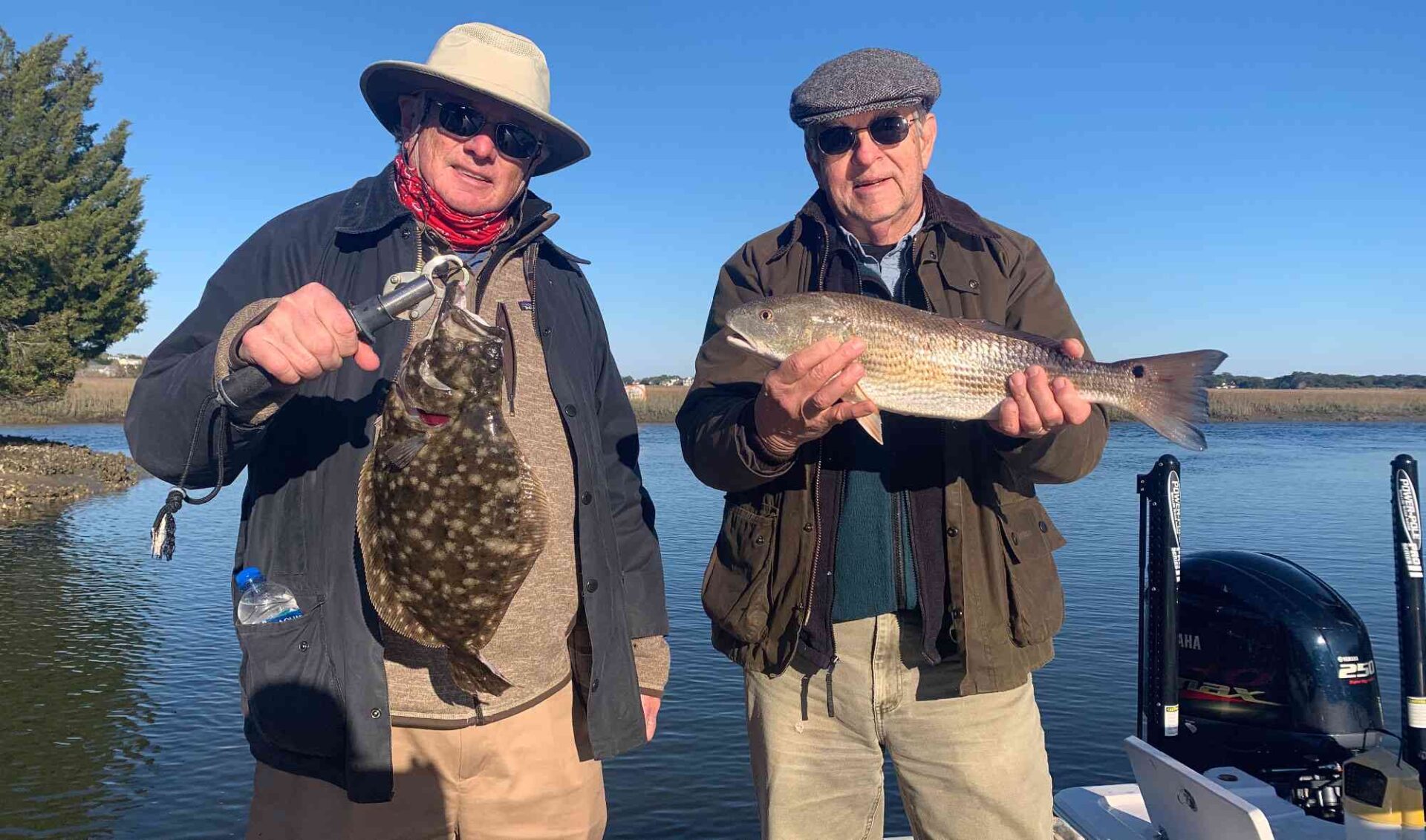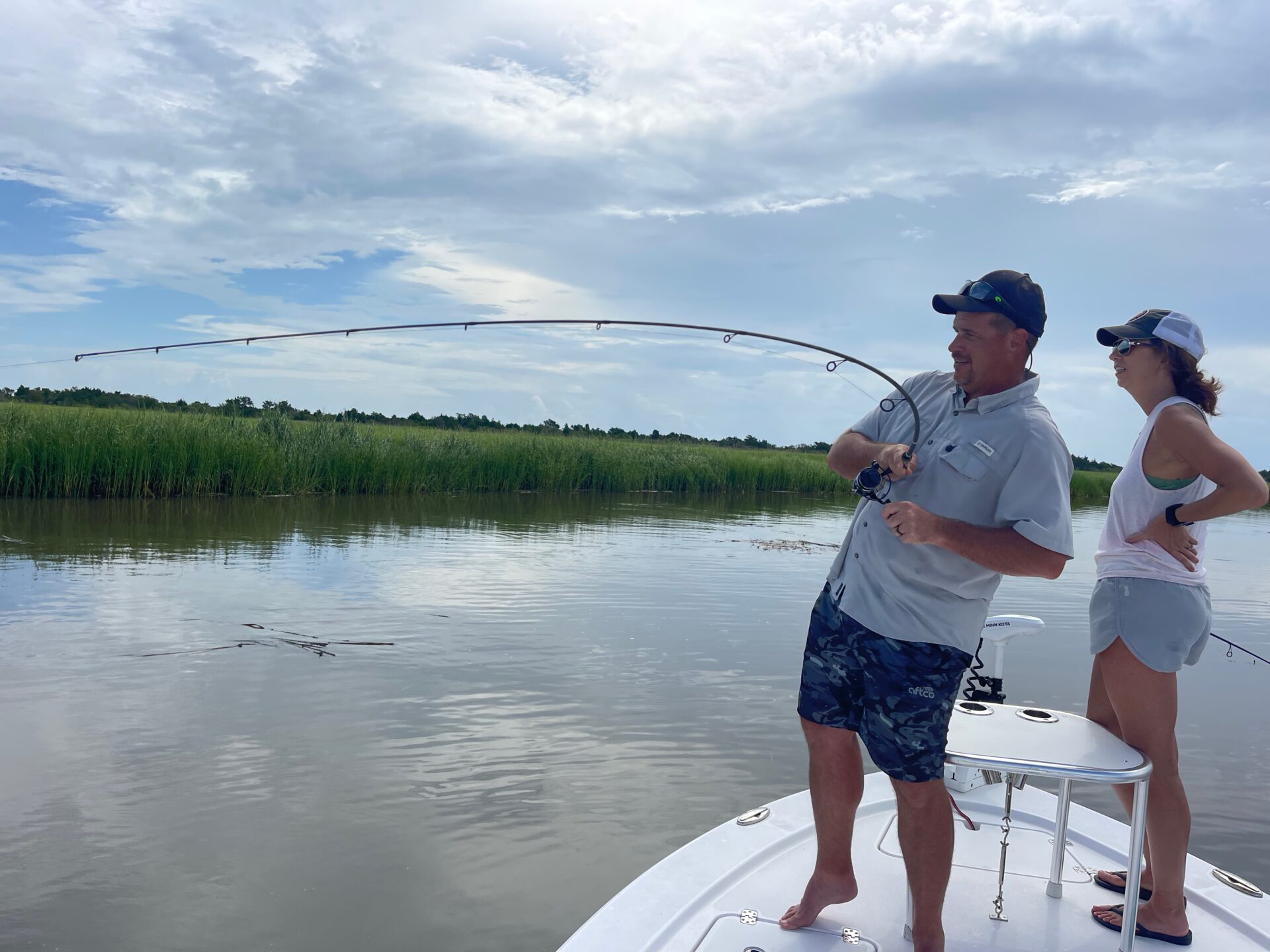Last Updated on October 16, 2025 by Eric Bonneman
When the heat finally breaks and a cool north breeze slides across the marsh, coastal Carolina transforms. The bugs disappear. The light sharpens. The water clears. Beneath that still surface, every predator in the estuary starts feeding like it knows the clock is ticking.
Fall is not just another fishing season here; it is the one locals wait for all summer. The air smells different, the tides run cleaner, and the energy changes. Red drum, speckled trout, and flounder all move into predictable patterns, and if you learn their rhythm, you will find the kind of action that makes every early morning worth it.
Reading the Fall Transition
The change does not happen overnight. It starts with a few cooler mornings and stretches deep into November, sometimes longer if the weather holds steady. The key is not air temperature but water temperature. Once it dips below seventy-five degrees, the entire ecosystem begins to shift.
Where the Fish Go
Red drum leave the deeper backwaters they favored in summer and begin schooling in shallow creeks and across grassy flats. You will often spot them pushing wakes or flashing bronze in knee-deep water.
Trout move toward structure and current. They hang near oyster mounds, creek mouths, and points where shrimp and mullet are funneled through tight spaces. Their bite turns on strongest during the outgoing tide.
Flounder stage along sandbars and creek edges, ambushing bait as it funnels out with the tide. In fall, they feed with an urgency you can feel through the line.

Pay Attention to the Signs
Every ripple tells a story. Bait flicking along a bank, birds circling, even the scent of the water changing after a cold front, all are signs that fish are on the move. Fall fishing rewards observation more than aggression. Guides who excel this time of year are the ones who slow down, watch, and adjust with each shift of the tide.
How Weather Shapes the Bite
Cold fronts and wind direction are the quiet forces behind success in fall. A single night of north wind can drop the water level and pull fish into deeper pockets. South winds ahead of a front often flood the grass, drawing redfish up into hard-to-reach shallows.
Cloud cover matters too. Bright days make sight-fishing for reds easier, but trout feed more confidently under overcast skies or in the soft light of dawn and dusk.
The real art lies in adaptation. Fall conditions change quickly, and anglers who treat each day as a puzzle instead of a formula tend to find the reward.
Gear, Tackle, and Tactics
Fall does not demand fancy gear, just thoughtful setups. A medium spinning rod around seven feet paired with ten- or fifteen-pound braid and a short fluorocarbon leader will handle almost every inshore situation.
Lures and Live Bait
• Soft Plastics: Shrimp imitations and paddletails on light jig heads stay productive in nearly every tide.
• Topwater Plugs: The calm mornings of October are perfect for surface strikes from trout and reds.
• Live Bait: Shrimp and mullet remain unbeatable for consistent action, especially under a popping cork.
Presentation counts as much as lure choice. In cooler, clearer water, fish can be selective. Work slowly, match the speed of the current, and stay deliberate. One careless cast can scatter an entire school of reds.
Timing and Tide
Tide windows in fall can be short. Knowing when a flat floods just enough for tailing reds or when trout stack on an outgoing creek mouth separates guesswork from success. Guides live by those details. Years on the water teach when to be patient and when to move.
Why Hiring a Guide Makes It Effortless
Fishing the Carolina coast in fall is rewarding but complex. Wind, moon phases, tides, and bait migration all shift together. A guide untangles that web for you.
Carolina Guide Service takes care of every part of the process. Tackle, bait, licensing, and most importantly, up-to-date knowledge of where the fish are that day. Each trip adjusts to the week’s conditions. When reds move deeper, you will be there. When trout feed on a certain tide, your guide already has it marked.
For first-time visitors, it is the easiest way to experience a true Carolina fall. For experienced anglers, it is a shortcut to better understanding the water. A good guide does not just find fish; they teach the logic behind them.
And maybe the best part is what you do not have to do. No guessing, no rerigging, only a steady tide, the hum of the motor, and the clean rhythm of casting until something strikes.

The Feel of Fall on the Water
By late October, the coast settles into a kind of peace. The grass turns bronze, the sun hangs lower, and the creeks smell sharp and clean. Redfish tail in the shallows, trout strike hard on surface plugs, and every fish seems a little heavier than it was a month ago.
It is also quieter. The summer crowds are gone. There is space to think, to fish, and to watch the world change by degrees. Every angler who loves this place knows that feeling, the combination of stillness and anticipation that defines the season.
Why This Season Matters
Fishing is about more than catching fish. It is about learning how water, weather, and life connect. Fall is when those lessons are easiest to see. The marshes breathe slower, the tides sharpen, and every movement makes sense if you are patient enough to notice.
Guided or solo, this is the time to be out there. The window is short, but it is the best of the year. When winter finally cools the water, you will remember the sound of a tail slapping the surface, the clean pull of the tide, and how alive the Carolina coast feels before the quiet season sets in.
If you are ready to experience that feeling firsthand, to see the Lowcountry at its best and learn from captains who live by its tides, book a trip with us and spend a day on the water that reminds you why fall in Carolina is worth waiting for.
